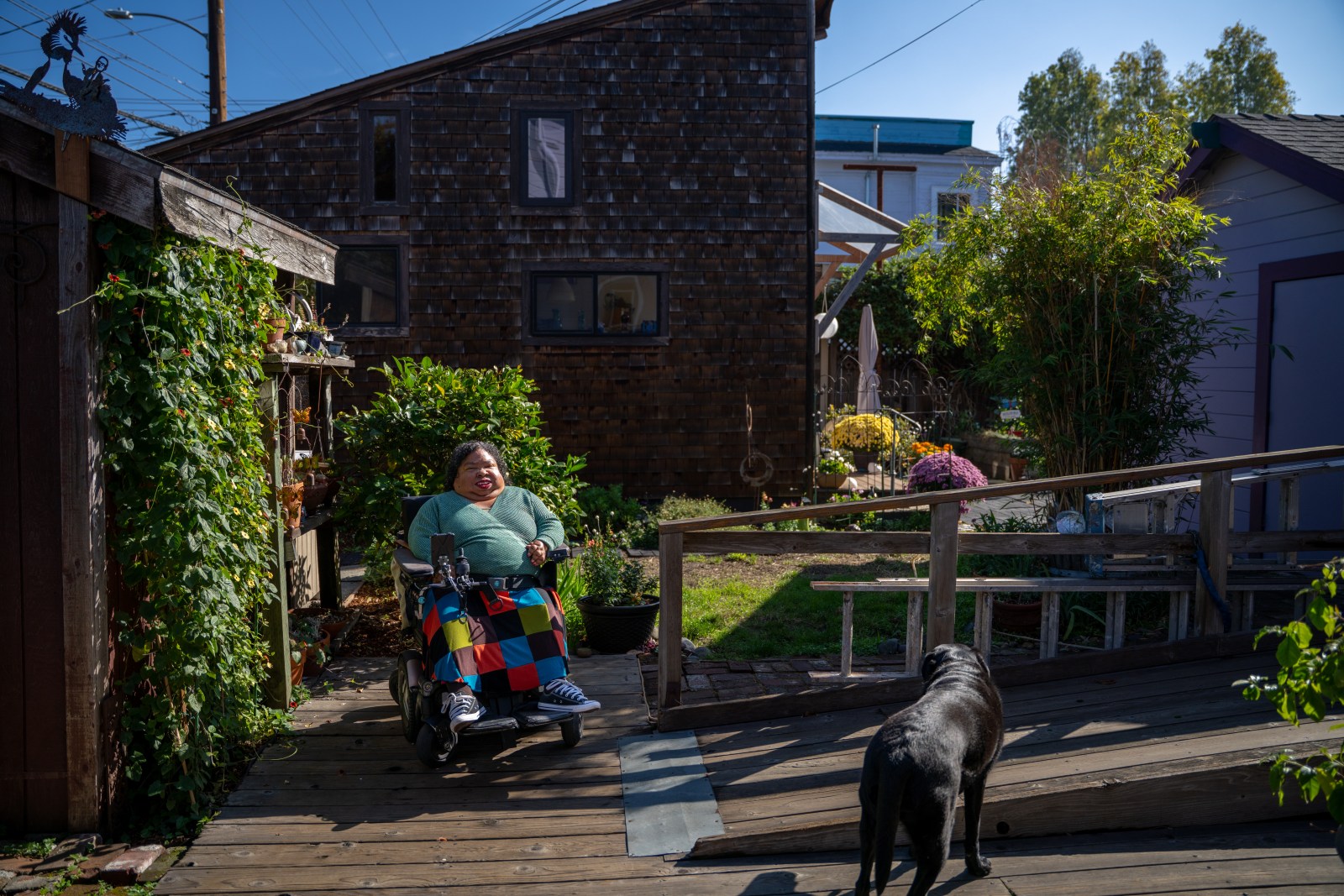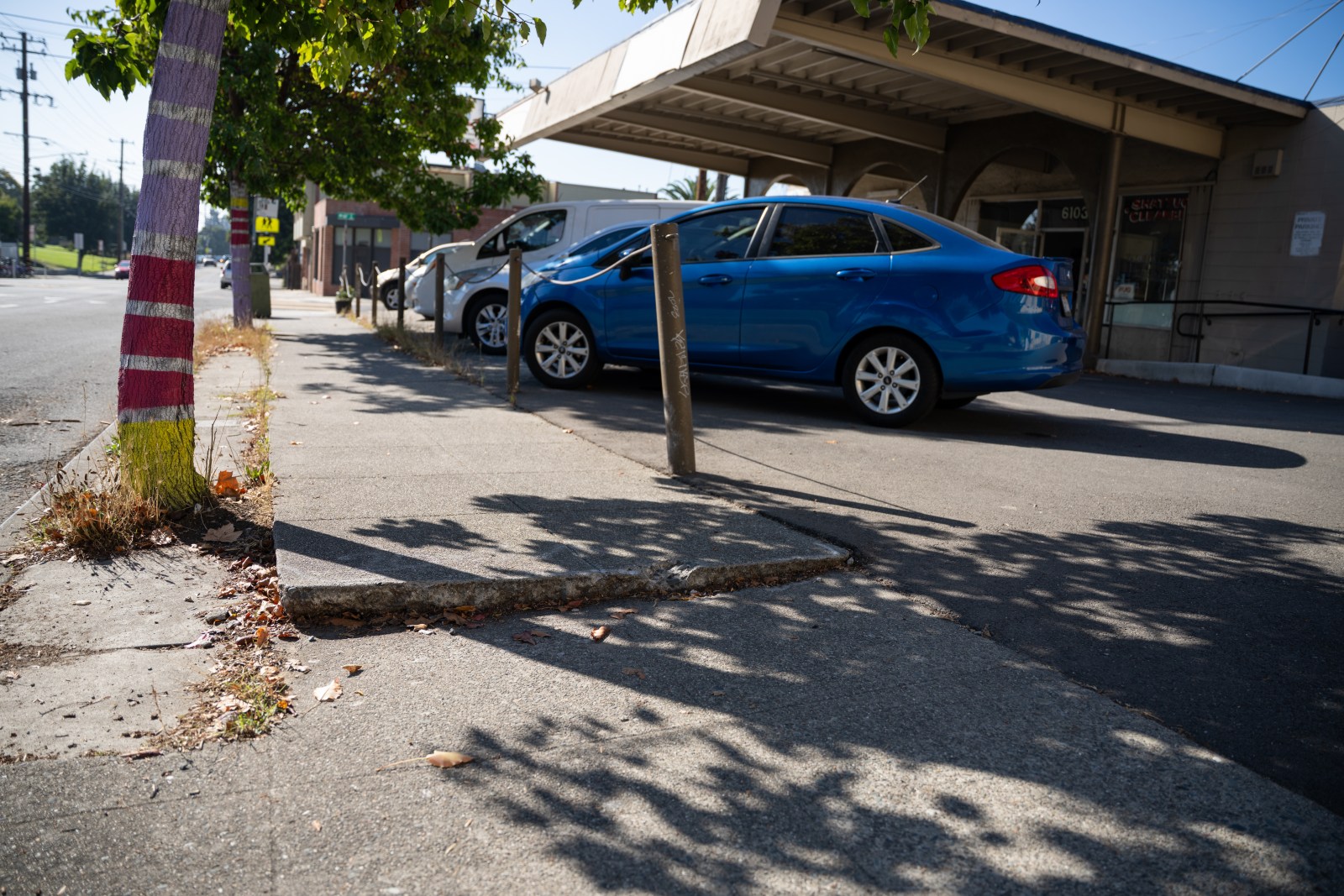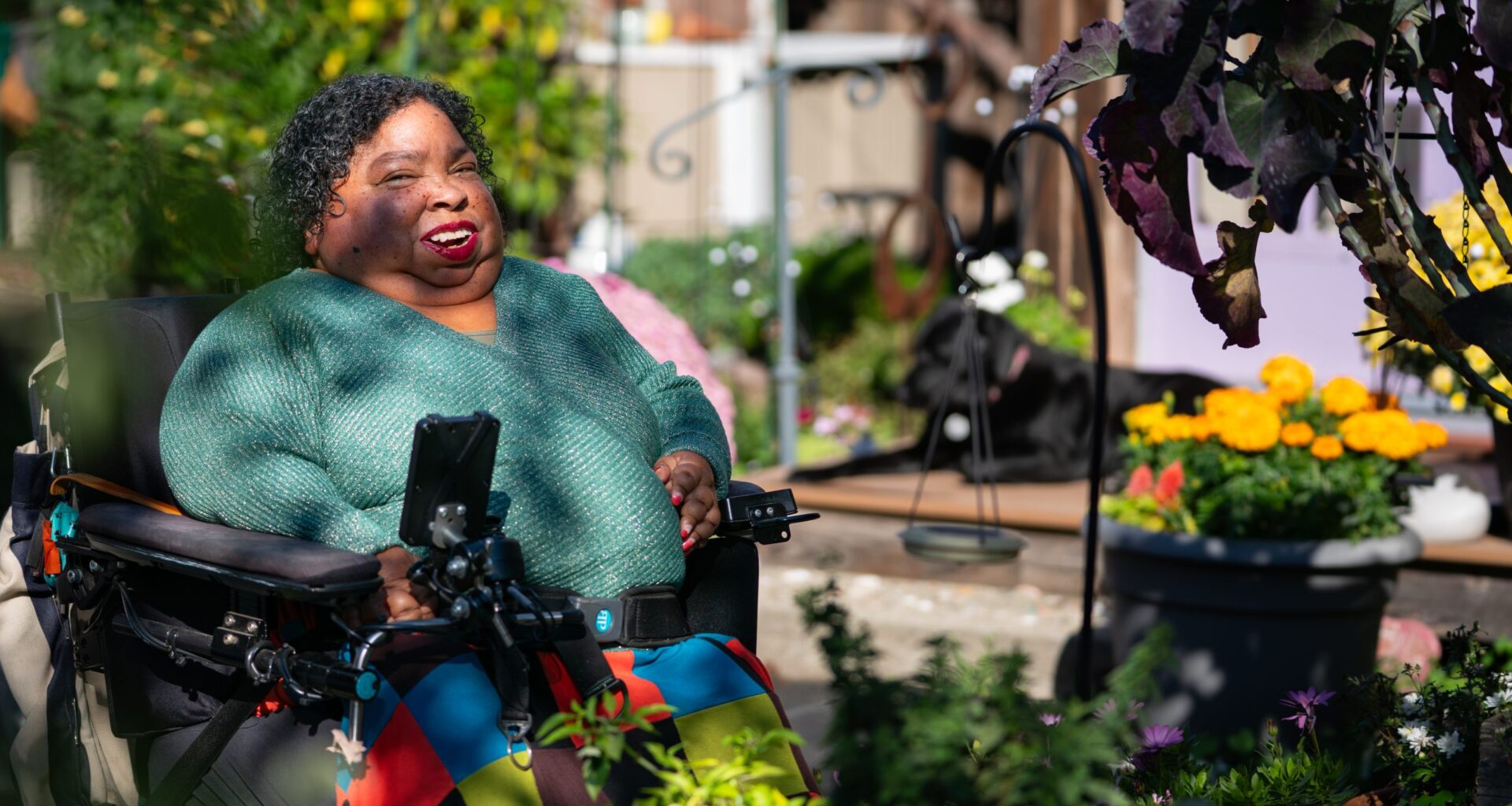Nicole Brown-Booker, an Oakland resident and disability advocate, has long used a wheelchair to navigate Oakland’s potholes and ragged sidewalks. And she has long believed that she has the same right to travel safely in Oakland as any able-bodied person.
But the city’s poorly managed sidewalks, which often jut from the ground, pushed up by tree roots, or break into jagged pieces thanks to temperature changes and earthquakes, have made it nearly impossible for the 59-year-old to get around. That’s why she decided to do something about it: sue the city.
In that lawsuit, Curran v. City of Oakland, Brown and a second plaintiff, Michael Curran, another Oakland resident, claimed that the city had violated the Americans with Disabilities Act by keeping its sidewalks in “a condition not suitable or sufficient for use.” The pair officially filed the suit in May 2023 as a class-action case that has attracted the attention of disability advocates across the country.
Last summer, the suit reached an incredible conclusion, with Oakland Mayor Barbara Lee announcing a settlement in which the city committed to fixing 11,000 curb cuts over 15 years and 78,000 problem sidewalks and the remainder of the city’s curb cuts over 25 years.
Brown-Booker spoke with The Oaklandside about the landmark legal settlement, and what her daily life looks like — living and traveling in Oakland.
The following conversation was edited for length and clarity.
Nikki, first of all, congratulations on the settlement. We first spoke a few years ago during a protest action against the city’s unsafe streets, not too far from your home in North Oakland — and I’m excited to hear more about your life and your activism. What do you do for a living?
I work for a foundation — the Borealis Foundation — where I’m a program director. I run a national fund called the Disability Inclusion Fund. We resource grassroots, new, and emerging disability justice organizations around the country to help out individuals, sometimes connected to disabilities. We’ve given out close to $30 million over the last five years.
What kinds of programs do you fund?
Senior and Disability Action, which you have written about and who brought me to that action where we first met, is a grantee. We support community organizing; arts and narrative change; criminal justice reform; mental health — many intersections. We have a project that resources Black disabled–led organizations — 10 grantees in the first cohort, with another 10 or so to come. We do annual grants and rapid response, usually for disasters or urgent needs.
Does your organization, or do your grantees, expect to be affected by the federal government cuts?
Yes, and it’s already happening. More grantees are reaching out — arts organizations cut by the National Endowment for the Arts is one. And we support many disabled, trans-led groups — they’re rethinking their strategies right now. Some directors are being doxxed by right-wing groups, we’ve heard. There was a recent memo about funding groups deemed not aligned with the federal government and classifying support as “domestic terrorism.” They’re calling out large foundations like Open Society. Philanthropy overall is concerned with who’s targeted next. So we’re doubling down to get money where it needs to go, but being careful about the information we ask for to avoid putting grantees at risk.
 Brown-Booker in her backyard with her dog and her custom ramps. Credit: Florence Middleton for The Oaklandside
Brown-Booker in her backyard with her dog and her custom ramps. Credit: Florence Middleton for The Oaklandside
Tell us about where you grew up and some of the challenges you faced getting around.
I grew up in Vallejo and moved to attend the University of California at Davis at 18. I can’t say I paid much attention to sidewalks as a kid — back then, there weren’t curb cuts like there are now. But Davis is very accessible. It’s flat; the campus was ahead of the game. Its sidewalks had curb cuts, and they were maintained well. It’s a city of bicycles, too, so I used a lot of bike lanes to travel and never really had issues. When I moved to Oakland, I was like, “Oh, this is a real big city, and yet there were so many issues.” I’d have to use people’s driveways to get up and down the sidewalk, rather than curb cuts, because they weren’t necessarily at every corner.
What kinds of risks do you face when you have to go up into somebody’s driveway?
I have to go into traffic, go around parked cars — some are big like trucks — and ride in the street, on the road itself, because it’s usually flatter and easier to navigate, until I can get to another curb cut or driveway that I can drive up on. And sometimes I’d get to the end of the block and realize there’s no curb cut there, and I’d have to duck back into the street again. That was a pretty regular occurrence in my neighborhood. Or really everywhere in Oakland — North Oakland, Downtown. Downtown had curb cuts, but they were really steep. A lot of times, the curb cuts weren’t at the corners; they’d be slightly off, so you’d cross and have to go somewhat off the corner to get back up.
At 17th Street by the Fox Theater and the Paramount Theatre, the curb cuts weren’t lined up with the crosswalks. I know in particular that one is really steep. And when the curb cuts are really steep, they fill with water when it rains. So when that happens, I have to either go through the water and risk damaging my chair, or avoid that corner and go to another one where the water isn’t pooling. It can take a long time.
Describe what happens when it rains.
Some curb cuts become like little rivers. I’d have to go into the street and find a driveway that wasn’t so bad. There are plenty of areas that are particularly bad during bad weather, and the sidewalks are jagged. When sidewalks are really uneven, I sometimes have to drive at an angle to get over them.
Is that because of the power of the chair or the size of the gaps? And what is the role of tree roots?
Sometimes the uplift can be two or three inches, which is hard to navigate even with a power chair. I’ve had to backtrack many times. Tree roots in particular — there are so many in North Oakland. Also, just old sidewalks that degrade and crack. We’re in earthquake country, too. Primarily, old sidewalks are not properly maintained.
Where in Downtown did you live and for how long? And how did you find the infrastructure there?
I lived at 12th Street and Martin Luther King Jr. Way, across from Preservation Park in West Oakland, for about four years. Sidewalks were generally better Downtown, but curb cuts were still a problem — especially in bad weather — and were often steep rather than gradual. The tactile warning strips — the little nubby yellow panels — weren’t on most sidewalks Downtown until more recently. Those strips help with traction when it’s steep; they give you a little grip.
And walking up Grand Avenue toward Lake Merritt — the sidewalks there are really bad, cracked and uneven.
I know you sometimes use bike lanes for your wheelchair, including ones that aren’t protected from car traffic by a concrete barrier. How safe do those lanes feel? A young girl, Maia Correia, was killed two years ago when she and her dad were hit while they were biking next to Lake Merritt.
That’s almost happened to me a couple of times. I’m usually very alert, but sometimes you can’t avoid being on the street — it’s unavoidable in many places, and often bike lanes are the best option compared to destroyed sidewalks. I know where sidewalks are bad; sometimes I pick a different street or go into the street to get around a bad section. Downtown has so much construction right now, so getting on the road and on those bike lanes is often unavoidable.
And when it comes to construction, sometimes you don’t see hazards until you’re right on them. Temporary curb cuts can be really steep or force you into traffic to even get into pedestrian right-of-ways.
I often have to backtrack — so many times. I haven’t submitted formal complaints to the city. Usually, I just get frustrated, go around, and it makes me late. With construction, you don’t know it’s there until you get there — something that wasn’t there last week is suddenly there.
What do you think about Oakland’s crosswalks?
Most crosswalks are okay, but problems happen at the curb cuts — because a lot of sidewalks aren’t aligned perfectly with crosswalks. You’ll cross straight, and the curb cut is off-center, so you have to jog left or right to get up, which is dangerous. Drivers get tunnel vision; if you’re out of the crosswalk alignment, you’re in a gray zone.
 Brown-Booker says many of the sidewalks near her home are treacherous to navigate. Credit: Florence Middleton for The Oaklandside
Brown-Booker says many of the sidewalks near her home are treacherous to navigate. Credit: Florence Middleton for The Oaklandside
Let’s talk about the civil suit you filed with Michael Curran. How did it start? And what made your attorneys think that this class action could work?
Well, I had actually worked with my attorneys on another sidewalk case, many, many years ago. That time, I had issues at the Apple Store in San Francisco, where I couldn’t access parts of it properly. So I knew Catherine Cabalo, one of the attorneys, and she then reached out to me about this class action case. I was totally like, “I would love to come onto this case because I’ve had so many problems with the sidewalks and the curb cuts — just even in my neighborhood in Oakland.” So I was like, “Yeah, count me in.”
What was the strategy?
They wanted to get the City of Oakland to really pay attention to the fact that the sidewalks and curb cuts had really poor access — to the point where many of them were dangerous to use. I mean, Oakland has some of the worst streets, right? The potholes and the infrastructure are really lacking and need help, particularly for people with disabilities. Everywhere I go, I run into problems with curb cuts and sidewalks, and I would have to go out of my way to avoid certain ones all the time. It was really frustrating — even in more upscale neighborhoods like Rockridge, where I do most of my shopping, I was running into issues with sidewalks and curb cuts.
The case took years, right?
We started working on the suit a few years before the pandemic. Once the pandemic hit, everything stalled.
It took forever. I hoped it would move faster. Even after things went “back to normal,” it took several more years. Meanwhile, I had to deal with the issues daily, which was maddening. If they just did proper maintenance, we wouldn’t have had to do this.
We filed the suit in May 2023 and finally began serious settlement talks around January or February of this year. It still took another several more months of back-and-forth with the lawyers to reach the final settlement.
How much time did you spend with your lawyers over the last seven or eight years?
Hours and hours. At one point, earlier this summer, I spoke with my lead lawyer, Cat, almost once a week. We’d talk for five or six hours a month. Lots of emails. Early on, she asked me to think about places with issues; I walked and rolled around, noting them — probably for 40 to 50 hours. We’d pull up Google Maps and Street View on Zoom and mark locations. We really mapped North Oakland well.
How did you feel when you won?
I was happy that there was a resolution. I know Oakland knows what needs to be fixed, but the timeline is long — decades. At least now the city is compelled to act. Without the suit, they wouldn’t have paid attention; now they’re legally bound. I’ve already seen some repairs — College Avenue curbs are better.
I’m glad they’re paying attention, but I’m annoyed that we had to sue.
Have you heard from disability advocates around the country since the settlement?
People think it’s great and want it in their cities.
I travel a lot for work — some cities are good, some are really bad. DC is pretty good; maybe because of the snow, they inspect more. Chicago is mixed — downtown sidewalks aren’t great. New Orleans sidewalks are really bad. Manhattan has curb cuts pretty much everywhere, but many are steep. Sidewalks are hit-or-miss; it’s better in tourist areas than in neighborhoods. The streets and pavement there are terrible.
San Francisco has curb cuts everywhere, but many are steep and sometimes off corners; I’ve had to go into traffic because curb cuts were bad. More newly built areas are good, but downtown needs work.
If the City of Oakland were to become more mindful about its road design moving forward, what would you like to see the city do?
For one, they could put up notices ahead of time that construction is coming and there may be obstructions — ideally, a week or two in advance. A schedule or map by email would be great; they know ahead of time from permits which roads will be worked on, but maybe no one is tasked with communicating it.
Potholes are another huge issue. I have an accessible van that’s lower because of the ramp; we’ll go over a bump, and you can hear it scrape. Tires get damaged. In an accessible van, bad potholes jostle you more — my attendants drive extra slow on certain streets to protect me and the ramp. It’s basically a low rider. Streets can be really bad.
What about bulbouts that narrow the road — in your experience, do they help slow cars and make it safer for people in wheelchairs?
Narrowing helps drivers slow down, but the problem is if bulbouts aren’t done well, you sometimes have to go around them. I like the barrier protection.
 A broken sidewalk on Shattuck Avenue near Brown-Booker’s home is so uneven she uses the adjacent parking lot to bypass it. Credit: Florence Middleton for The Oaklandside
A broken sidewalk on Shattuck Avenue near Brown-Booker’s home is so uneven she uses the adjacent parking lot to bypass it. Credit: Florence Middleton for The Oaklandside
When you travel, do you have a resource to look up street accessibility?
Not really. Some cities have walking trail maps — I’ve used those — but there’s nothing universal.
What would it be like if Google Maps directions had a wheelchair mode?
That would be amazing. They should hire people to map it, as they do for Street View. Even mapping central neighborhoods and thoroughfares would help.
What are the issues surrounding mass transit in the Bay Area?
I don’t ride the bus much. I mostly walk, drive, or take BART. BART’s new trains are nicer and easier to get on and off because of the smaller gap. They’re more consistent now: every car has a wheelchair space, which wasn’t true before. Elevators used to be an issue, but they’ve upgraded many. What I really hate are the new fare gates.
Why is that?
They don’t feel as wide. The Clipper reader is only on one side — even on the accessibility lane. I drive with my right hand, and the reader is on the right, so I have to stop, and sometimes I can’t reach it because of my wheelchair controller. I turn around, go backward to tap, then turn and go through.
The readers at the fare gates for these cards are also less sensitive than before, in my experience. Sometimes it takes extra tries and about 10 seconds to open. Sometimes they don’t open at all, and then the call button isn’t answered. I’ve had to wait for another patron to tell the agent to open the gate.
That is a potentially big problem. Have you told BART?
I’ve complained to agents about the gates.
Once, I had to buy an extra Clipper card because mine wouldn’t work, and there was no agent. I had to pay full fare even though I have a card with discounted disability access fare. The gates snap shut fast and sometimes don’t open fully. With my dog, it’s harder to maneuver in even less space than before. I’m not a fan, and they’re rolling them out everywhere.
The fact that there’s often no agent in the BART booth is an issue. They put gates in front of elevators; it’s convenient if it works, but if something goes wrong and there’s no agent, you’re stuck.
How accessible are car services for people with disabilities?
I use Uber for airport trips; in the East Bay, accessible Ubers are too few and take a long time. They sometimes never arrive, especially on weekend evenings. I’ve heard of drivers coming from San Francisco because there’s no accessible Uber available in the East Bay.
The Waymo cars are not accessible, so I haven’t used them. They make me nervous; I let them go first before crossing. I’ve seen them stop in the middle of the street and at crosswalks. Even if they wanted to be accessible, without a driver who ties you down, how would that work? I don’t know how they’d do securement. Society needs to consider accessibility from the start.
“*” indicates required fields

